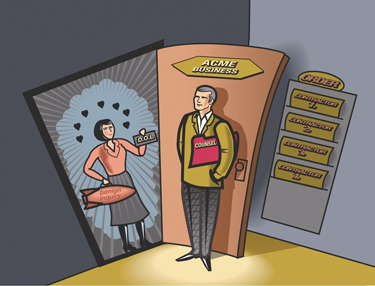Defending Your Independent Contractor Classifications
How to audit your independent contractor classifications before the DOL does.
 Using independent contractors can be a good way for companies to meet their business goals. But these days, doing so is akin to putting a neon target on your back. As the U.S. Department of Labor (DOL) seeks to convert as many contractors as possible to employees, many companies that use independent contractors are facing a very real threat.
Using independent contractors can be a good way for companies to meet their business goals. But these days, doing so is akin to putting a neon target on your back. As the U.S. Department of Labor (DOL) seeks to convert as many contractors as possible to employees, many companies that use independent contractors are facing a very real threat.
Addressing misclassification has become a key government priority. Indeed, DOL spokeswoman Mary Beth Maxwell recently called the misclassification of workers as something other than employees—typically as independent contractors—a “serious problem for affected employees and employers, and to the economy.”
Moreover, the DOL’s Wage and Hour Division continues to focus with great urgency on misclassification. In recent years, it has launched many related investigations and lawsuits.
So how does the DOL intend to forcibly convert independent contractors to employees—and what can you do about it?
Setting Targets
The DOL and IRS are working together and sharing information to identify potential misclassification of employees. Their goal is to increase tax revenue and investigate compliance with federal labor laws.
In addition, the DOL is targeting specific industries that will bear the brunt of its increased attention, including energy, construction, home health care, child care, transportation, parking, warehousing, and meat and poultry processing—basically any industry in which labor is not closely controlled by management and independent contractors may be needed. Many experts believe the construction and energy sectors will be scrutinized the most closely.
Being Targeted
An investigation will most likely begin with an opening letter, which is often delivered in person by a DOL investigator. The letter will seek detailed information regarding your company, its finances, and its payroll and operating practices. And, in typical government fashion, you’ll be given little if any time to formulate a precise response.
The initial visit from an investigator often seems friendly and nonthreatening, but employers shouldn’t be lulled into a false sense of security.
What starts as a benign inquiry can spiral out of an employer’s control. Within weeks, a company that believes it is cooperating may face a demand for millions of dollars in back pay.
Unfortunately, even when independent contractor relationships are solidly established under the law, the DOL could still determine that the contractors are employees.
But don’t lose heart: If your company is confident in its position, an unfavorable administrative decision does not have to be a death knell to your business. Employers have the right, and now the precedent, to fight back.
Five-Factor TestNo single factor will determine the outcome of a misclassification inquiry, and every work relationship may be assessed differently. But most federal judges apply the following five-factor test to determine if a worker is an employee or an independent contractor, with the answers in parentheses indicating contractor status:• Does the worker or company control the details of the work? (Worker) • Does the worker or company supply the equipment needed to do the work? (Worker) • Does the worker have an opportunity to make a profit or suffer a loss in performing the work at issue? (Yes) • Is the relationship between the company and worker permanent or temporary, and is the work of an “on again/off again” nature? (Temporary, and yes) • Does the job require worker skill and initiative? (Yes) |
Fighting Back
When the DOL came knocking and cited Texas company Gate Guard Services L.P. (GGS) with a $6 million penalty for allegedly misclassifying its gate attendants as independent contractors, GGS refused to pay and instead filed its own lawsuit against the DOL in federal court—which the company won in 2014. This was a significant victory for companies that rely on independent contractors. The DOL, on the other hand, suffered a substantial loss: its appearance of invincibility when pursuing alleged “employee misclassification” actions under the Fair Labor Standards Act (FLSA).
Not only do employers have the right to fight back, but they may collect all or part of their attorney fees from the DOL. GGS was awarded over $500,000 because the federal district court found that the DOL was “not substantially justified” in pursuing litigation against the company.
However, the DOL has rarely lost an independent contractor misclassification case in federal court. One reason for this is that the department has virtually unlimited resources available. Most companies decide to capitulate rather than contest the case, either because they lack the financial means to fight back or they don’t realize that they can.
Defending Yourself
If your company relies on independent contractors and has not yet been investigated by the federal government, be proactive in auditing your use of independent contractors and prepare a response in advance.
Once you’ve determined the classifications to be legal, review and update independent contractor agreements—and follow them. Although they do not conclusively establish independent contractor status, these agreements are an important factor in determining who is an independent contractor. The agreements should state that the business lacks control over the means by which the worker performs his or her duties, that the term of the agreement is on a project-by-project basis, and that both parties intend the worker to be an independent contractor. The agreements should also establish that the worker:
- Uses his or her own equipment and tools.
- May perform services for other businesses.
- Can assign tasks to others.
- Provides his or her own liability insurance and benefits.
- Is not eligible for employee benefits.
- Has his or her own business and tax identification number.
- Has the opportunity to receive bonuses or chargebacks.
You should enter into a new agreement for each project assigned and also should conduct a classification audit with your employment counsel. Performing an FLSA classification audit will help you identify potential FLSA compliance problems before the DOL does and mitigate the risk that you’ll be audited by the IRS, the DOL, or any other federal or state agency. It may also create a good-faith defense to a liquidated damages claim for businesses that believe that their pay practices comply with the FLSA.
Finally, ensure that your company is treating its independent contractors as true contractors. Do not provide them with job descriptions, business cards, computers, office space or training; instead, insist that they provide most of their own equipment. Do not control the work; instead, allow the contractor to decide how the work will be performed. While companies can and should insist on safety and quality control measures, make sure you communicate that these directives are for safety purposes and to ensure that the customer receives a quality service or product.
So be prepared. Be proactive. Structure your business appropriately with the help of knowledgeable counsel. And do not be afraid to fight back if you are in the right.
Annette A. Idalski is an attorney with Chamberlain Hrdlicka in Atlanta and can be reached at annette.idalski@chamberlainlaw.com.
Web Extras
- SHRM article: DOL Takes Aim at Independent Contractor Misclassification
- SHRM article: Mass.: Worker Is Employee, Not Independent Contractor
- SHRM article: Nev.: Exotic Dancers Are Employees, Not Contractors
- SHRM article: California FedEx Drivers Were Employees, Not Independent Contractors
- SHRM article: Audit Checklist for Maintaining Independent Contractor Status
- SHRM webpage: SHRM Online Legal Issues home page
Advertisement
An organization run by AI is not a futuristic concept. Such technology is already a part of many workplaces and will continue to shape the labor market and HR. Here's how employers and employees can successfully manage generative AI and other AI-powered systems.
Advertisement



